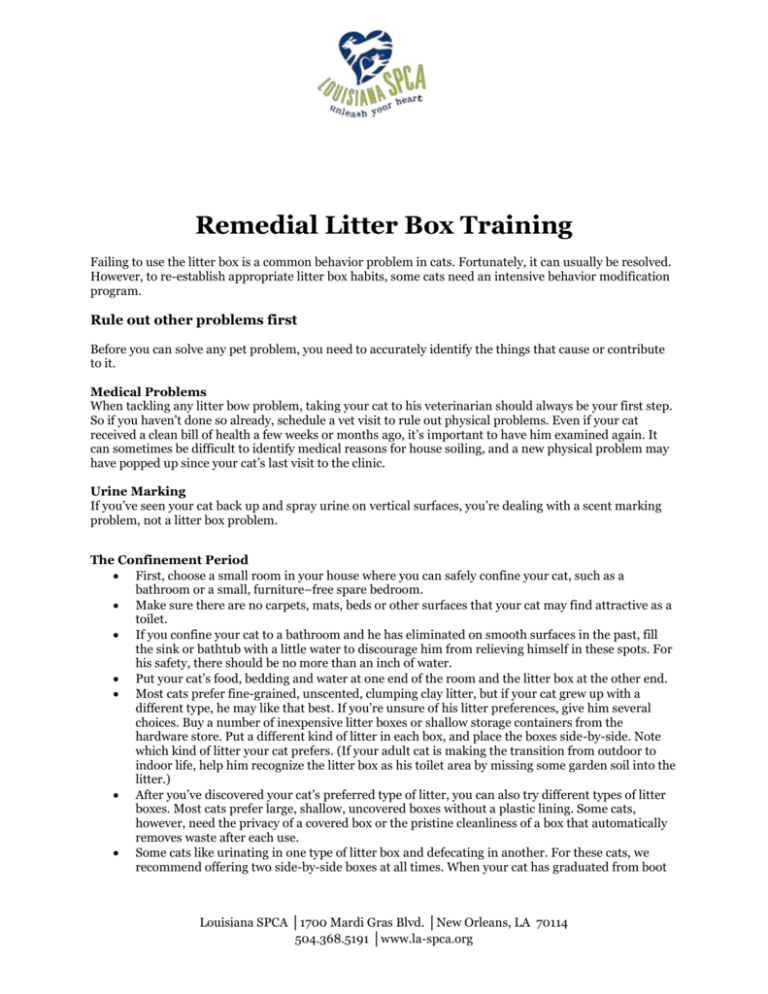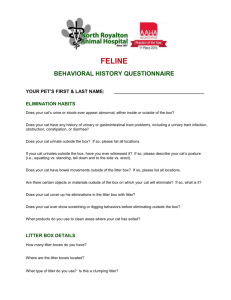Remedial Litter Box Training
advertisement

Remedial Litter Box Training Failing to use the litter box is a common behavior problem in cats. Fortunately, it can usually be resolved. However, to re-establish appropriate litter box habits, some cats need an intensive behavior modification program. Rule out other problems first Before you can solve any pet problem, you need to accurately identify the things that cause or contribute to it. Medical Problems When tackling any litter bow problem, taking your cat to his veterinarian should always be your first step. So if you haven’t done so already, schedule a vet visit to rule out physical problems. Even if your cat received a clean bill of health a few weeks or months ago, it’s important to have him examined again. It can sometimes be difficult to identify medical reasons for house soiling, and a new physical problem may have popped up since your cat’s last visit to the clinic. Urine Marking If you’ve seen your cat back up and spray urine on vertical surfaces, you’re dealing with a scent marking problem, not a litter box problem. The Confinement Period First, choose a small room in your house where you can safely confine your cat, such as a bathroom or a small, furniture–free spare bedroom. Make sure there are no carpets, mats, beds or other surfaces that your cat may find attractive as a toilet. If you confine your cat to a bathroom and he has eliminated on smooth surfaces in the past, fill the sink or bathtub with a little water to discourage him from relieving himself in these spots. For his safety, there should be no more than an inch of water. Put your cat’s food, bedding and water at one end of the room and the litter box at the other end. Most cats prefer fine-grained, unscented, clumping clay litter, but if your cat grew up with a different type, he may like that best. If you’re unsure of his litter preferences, give him several choices. Buy a number of inexpensive litter boxes or shallow storage containers from the hardware store. Put a different kind of litter in each box, and place the boxes side-by-side. Note which kind of litter your cat prefers. (If your adult cat is making the transition from outdoor to indoor life, help him recognize the litter box as his toilet area by missing some garden soil into the litter.) After you’ve discovered your cat’s preferred type of litter, you can also try different types of litter boxes. Most cats prefer large, shallow, uncovered boxes without a plastic lining. Some cats, however, need the privacy of a covered box or the pristine cleanliness of a box that automatically removes waste after each use. Some cats like urinating in one type of litter box and defecating in another. For these cats, we recommend offering two side-by-side boxes at all times. When your cat has graduated from boot Louisiana SPCA │1700 Mardi Gras Blvd. │New Orleans, LA 70114 504.368.5191 │www.la-spca.org camp and you allow him more freedom around the house, you may find that he prefers to have these boxes in different areas. If your cat still doesn’t use his litter box when confined in a small room, you can use a large dog crate or commercially available cattery to house your cat during litter box boot camp. Place food, water and bedding at one end of the enclosure and one or more litter boxes at the other end. If your cat soils fabric, don’t provide a bed. Instead, you can offer a perching box or shelf, a pile of newspapers or a paper bag for him to crawl into. Puppy house training pads are another soft, nonfabric alternative to regular bedding. If your cat still fails to use his litter box, try covering the entire floor of his small confinement are with litter. He’ll have no choice but to use his box when he needs to relieve himself. Keep in mind that you’ll need to provide a sleeping area, such as a bed, perch or cozy bag. Keep the box clean It’s crucial to keep your cat’s litter box very clean while he’s confined to a small area. Cats have very sensitive noses, and you don’t want to teach your cat to avoid a dirty litter box. Scoop at least twice a day. Once a week, wash the box with water or a small amount of mild soap and then fill it with new litter. Provide exercise and enrichment Keep in mind that your cat needs plenty of socialization and exercise during the confinement period. Set aside time each day to visit your cat in his room or take him into a larger room so that he can run around and stretch his legs. Thoroughly clean trouble spots During the confinement period, give your house a good cleaning. Use an enzymatic product made for cleaning pet waste to scrub every trace of odor from areas where your cat has eliminated in the past. Don’t replace soiled furniture or carpeting just yet – but plan on doing so in the future, as soon as your confident that your cat’s house soiling problem has been resolved. Reintroduction to your house To firmly re-establish good litter box habits, your cat needs to stay in his confinement area for two to four weeks. Once he reliably uses his box, you can start to gradually give him more freedom in your house, one room at a time. Make sure your cat has access to a litter box in each room at first. Keep a litter box in his former confinement area as well so that he can return there to eliminate if he’d prefer. Find ways to discourage your cat from returning to his favorite spots to house soil. Effective deterrents include closed doors, foil, double-sided tape, upside-down carpet runner, the ScatMat® and SSSCAT® repellant devices. Use these deterrents for at least a month after boot camp if over. You may find that you’re caught in a cycle of confining your cat and then gradually giving him freedom, only to have him start soiling outside his litter box again and wind up back in confinement. If you’ve repeatedly tried boot camp for more than nine months, it’s time to acknowledge that this program is not going to work for your cat. Should your cat live outdoors? Statistically, outdoor cats are not as long-lived as indoor cats because cats that go outside encounter dangers like predators and exposure to disease. For the reason, the ASPCA does not encourage people to Louisiana SPCA │1700 Mardi Gras Blvd. │New Orleans, LA 70114 504.368.5191 │www.la-spca.org keep their cats outdoors. However, this option may be appropriate for cats who have a great deal of difficulty learning or re-learning litter box habits. If boot camp does not resolve your cat’s litter box problems and you’re contemplating euthanasia, consider making him an indoor/outdoor cat or an exclusively outdoor cat. Occasionally allowing a cat regular access to the outdoors completely resolves a letter box problem because the cat chooses to eliminate outside. If you decide to try this option, consider confining your cat in a screened area or other outdoor enclosure to keep him safe. Another option is to find a responsible barn owner to adopt your cat. As long as they’re young and healthy enough to make the transition, many former housecats can lead happy lives as barn cats. Louisiana SPCA │1700 Mardi Gras Blvd. │New Orleans, LA 70114 504.368.5191 │www.la-spca.org






